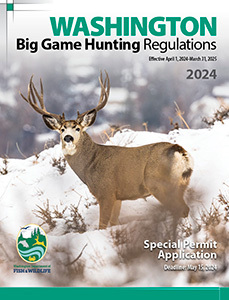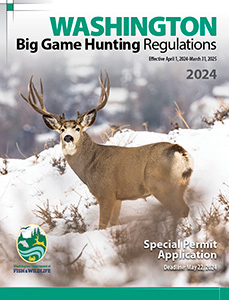Welcome to 2024-25 Washington Hunting


Washington hunters are nature lovers, outdoor enthusiasts, and critically, conservationists. If you have a conversation with someone about why they go hunting, harvesting an animal is not always the first thing they mention. Of course, filling the freezer and providing for our families is important, but hunters also cherish the opportunities we have to spend time with friends and loved ones afield and take pride in contributing to wildlife management and conservation.
I look back on so many experiences I’ve had while hunting that have nothing to do with the harvest: those unbelievable encounters and the thrill of sharing space with incredible wildlife in their natural habitat. Even when I don’t harvest an animal, I consider my efforts a success when I can experience these awe-inspiring moments and share them with others. I know that my financial investment as a hunter directly contributes to continued hunting opportunities in Washington.
The U.S. Fish and Wildlife Service recently released the latest National Survey of Fishing, Hunting, and Wildlife-Associated Recreation. Through this survey, researchers gathered the latest data about hunters' participation and spending in Washington and nationwide.
Survey results showed that, in 2022, approximately 290,000 people went hunting in Washington and spent approximately $1.1 billion dollars on equipment and trip-related expenses. This spending supports businesses and communities across the state, and taxes on this spending contribute to a variety of fish and wildlife management and conservation work. Washington hunters represented a wide range of age, gender, economic, and racial demographics, demonstrating that there is a place for everyone outdoors. Surveyed hunters also showcased the diversity of hunting opportunities in Washington, with the majority of hunters targeting big game.
These hunters – over a quarter of a million people – directly support Washington wildlife conservation through active population management and financial contributions that support the Washington Department of Fish and Wildlife’s work. At the Department, we appreciate everything you do to support wildlife conservation in our great state.
We sought out images of live big game animals for the cover of this year’s regulations pamphlet, and Washington hunters delivered. Department staff enjoyed looking through all submissions – over 500 photos! – and seeing the different wildlife hunters encountered in the field. Our chosen cover photo and all of the wonderful submissions remind us of the bigger picture of hunting in Washington and across the nation, a reminder of the ways hunting supports thriving ecosystems and the wildlife that live there.
As always, we wish you safe, successful, and memorable hunting seasons in the year ahead.
To learn more about the 2022 National Survey of Fishing, Hunting, and Wildlife-Associated Recreation results, please visit WDFW’s website.
Eric Gardner,
Wildlife Program Director

